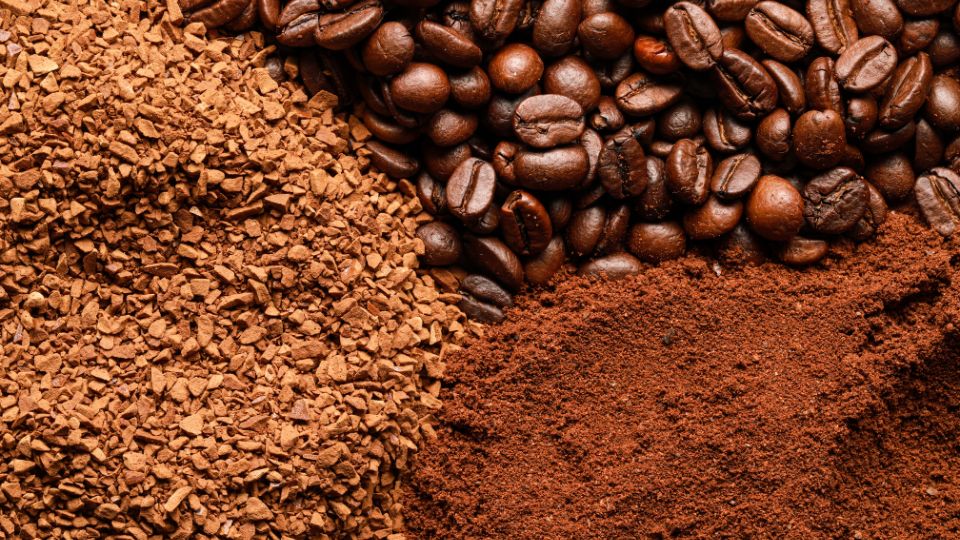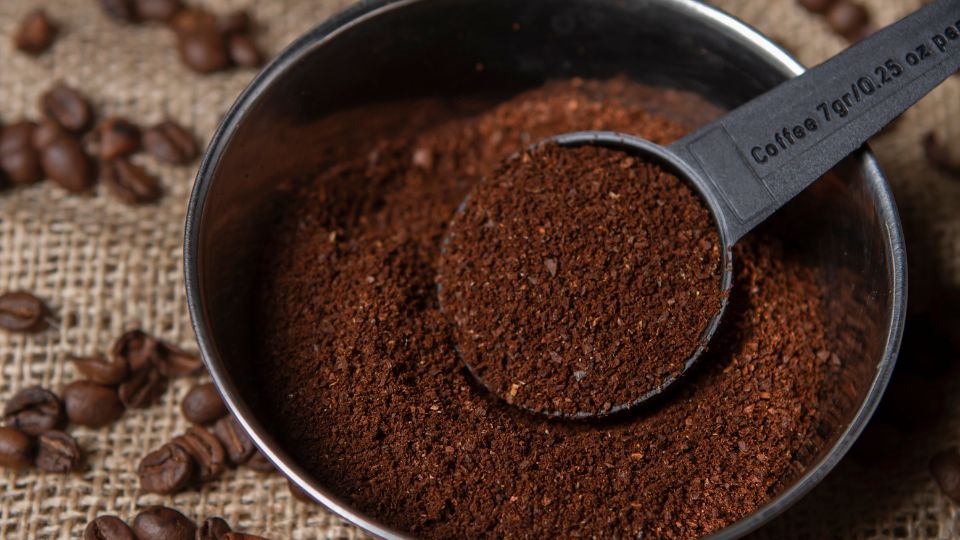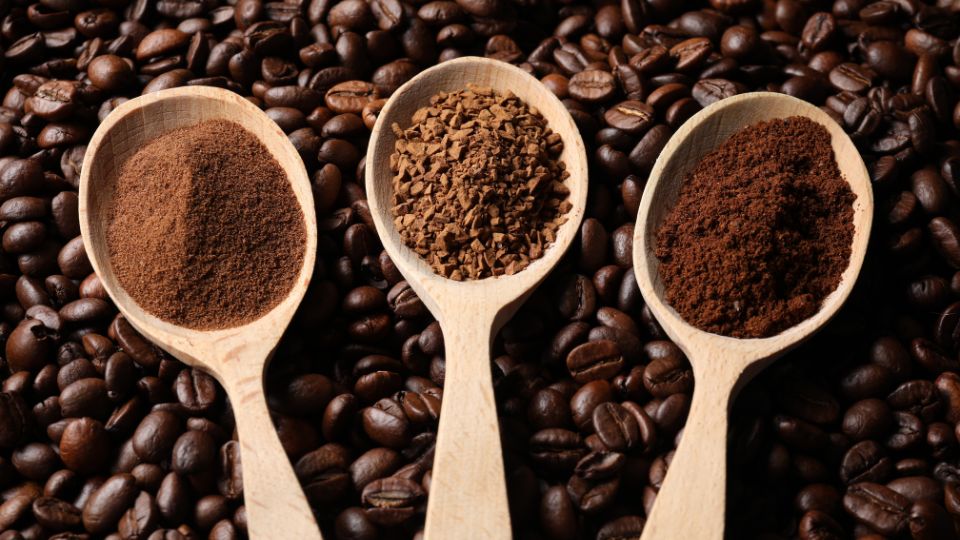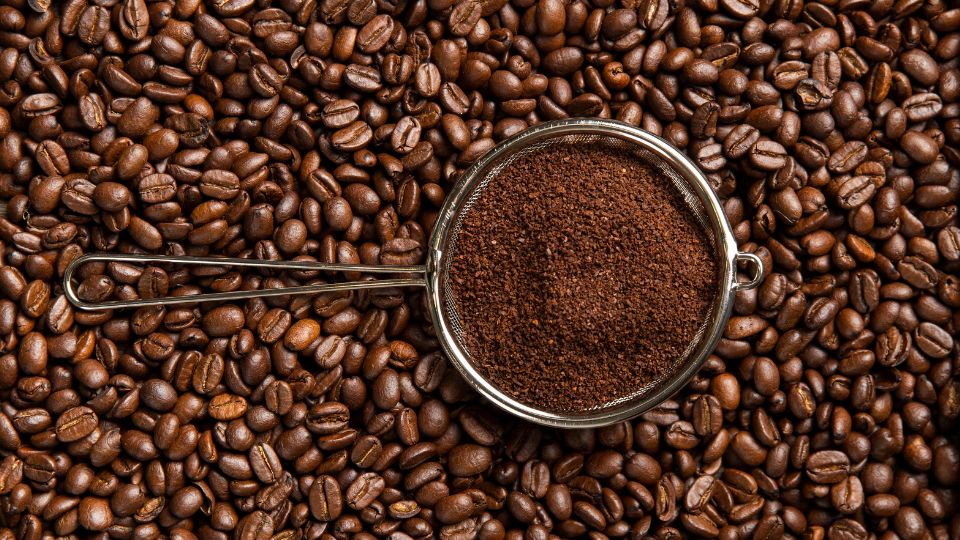Sieving coffee particles can have an impact on brewing in a variety of ways. Here’s how sifting coffee particles affects brewing:
- Extraction: The rate and depth of extraction can be altered by sieving the coffee particles. Coffee grounds are sieved to remove the smaller grounds while keeping the larger ones. Over-extraction and a bitter flavour may result from the smaller particles’ increased surface area. Nevertheless, under-extraction and a less robust flavour may come from using too big particles.
- Uniformity: Sieving coffee beans beforehand can help produce consistently sized grounds for brewing. Water flows more uniformly through the coffee bed and extracts more flavour when the particles are the same size throughout.
- Clumping: Uneven extraction can occur if the coffee grounds are not sieved to prevent the particles from clumping together. Coffee grounds that have been sieved are less likely to form clumps in the brewing basket.
- Brew time: The brew time may change if you want to sieve the coffee grounds. The brew time could increase if the coffee grounds were too finely ground. The brew time may decrease if the particles are too large. Sieving can shorten the brew time to the ideal length when using a specific brewing technique.
- Flavour: Sieving coffee grounds might change the coffee’s flavour. Coffee’s intensity and flavour can be altered by particle size and uniformity. You can improve the flavour profile by filtering out the particles.
Is It Preferable To Remove Particles Smaller Than 400μm?
In coffee preparation, whether it is better to sieve out particles smaller than 400μm depends on the brewing method and personal preference.
Finer particles can cause over-extraction and a gritty mouthfeel in brewing methods like the French press and Turkish coffee. To get a cleaner and smoother cup of coffee in certain situations, sieving away particles smaller than 400m may be helpful.
In contrast, smaller particles are typically preferred for other brewing methods, such as espresso or Aeropress, to extract more flavour and provide a richer, fuller-bodied coffee. Removing particles smaller than 400 m with a sieve in several situations may not be necessary or desirable.
The option to sieve away particles smaller than 400m when brewing coffee comes down to individual taste and the desired body and smoothness of the finished brew.

How Does Grain Size Affect Coffee?
Grain size is critical in determining coffee’s flavour, aroma, and overall quality. The particle size distribution of the ground coffee and the brewing method are all key elements that affect the final cup of coffee.
When coffee is ground, the size of the particles determines how fast the coffee extracts during brewing. Coarser grinds, for example, result in slower extraction times than finer grinds. Therefore, the grind size affects the brew ratio or the amount of coffee used in proportion to the amount of water.
Espresso machines require a fine grind size to achieve the high pressure and short extraction time necessary for espresso. A consistent, fine grind size is crucial to producing a balanced shot of espresso. On the other hand, drip coffee machines typically require a coarser grind size to allow for a longer extraction time and a larger brew ratio.
Generally, the ideal grind size depends on the brewing method. For example, a French press typically requires a coarse grind size to prevent the coffee from becoming too bitter. In contrast, pour-over methods like V60 or Chemex require a medium-fine grind size.
In summary, the grain size of coffee affects the brewing method, brew ratio, and, ultimately, the flavour and aroma of the brewed coffee. Choosing the right grind size for the desired brewing method is important to achieve the best possible cup of coffee.
Why Are We Sieving The Brewed Coffee And Coffee Grounds?
We sieve brewed coffee to remove unwanted particles affecting its flavour clarity. When coffee is brewed, fine particles and large particles are often not evenly extracted, which can result in an unbalanced taste. By sieving the brewed coffee, we can remove any excess fine particles or large particles that may have made it through the brewing process.
Additionally, the grind consistency of coffee grounds plays a crucial role in the quality of brewed coffee. Uniform particle size is essential for even extraction. In contrast, coarse particles can result in weak coffee, and fine particles can result in over-extracted, bitter coffee. Sieving helps ensure that the coffee grounds used in brewing are of a consistent size, which can improve the overall quality of the coffee.
A blind taste test conducted with sieved and unsieved coffee can help demonstrate the difference in flavour clarity. Sieved coffee often has a cleaner, brighter taste with more distinct flavours. In contrast, unsieved coffee can have a messy taste with less clarity.
It’s also worth noting that sieving can be particularly useful when using freshly roasted coffee, as these beans tend to have more fines and inconsistencies in size. Removing these particles can improve the quality of the coffee and bring out the full potential of the roasted coffee’s flavour profile.
What Are The Limitations of Sieving?
Sieving is a common method for separating coffee grounds from brewed coffee in coffee brewing. However, this method has limitations that may limit its utility in coffee brewing. Here are some of the limitations of sieving in coffee brewing:
- The Separation that isn’t complete: Sieving can leave some coffee grounds in the brewed coffee, causing a gritty texture and possibly altering the flavour.
- Filter clogging: If the coffee grounds are too fine or the sieve was not intended for the particular brewing method, sieving may cause the filter to clog.
- Limited control over coffee extraction: Sieving does not offer a means of controlling coffee extraction, which can result in over- or under-extraction and affect the flavour and standard of brewed coffee.
- Time-consuming: Sieving can take a lot of time, especially if the sieve needs to be cleaned or changed frequently.
- Inability to remove all particles: Sieving can only remove particles that are larger or smaller than the sieve size, and it cannot address particle size distribution issues. If the coffee powder has a wide range of particle sizes, sieving may not achieve a consistent grind.
- Brew Method: Different brew methods require different particle distribution, and sieving may only be appropriate for some brewing methods. For example, espresso requires a very fine particle distribution, and sieving may not be able to remove all the clumps or fines.
- Dissolved Solids: Sieving cannot remove dissolved solids already in the brewed coffee. It’s possible that simply sieving the coffee powder won’t enhance the flavour if it already has a high total dissolved solids (TDS VALUES).

How Do You Get Rid Of Coffee Clumps?
The following is a list of some of the methods that can be utilised to eliminate coffee clumps:
- Grind Setting: Adjust the grind setting on your grinder to produce a more consistent particle distribution. Extra fine or very coarse settings can result in clumps, so finding the right setting is crucial.
- Hot Water: Use hot water to pre-wet the coffee powder before brewing. This can help break up any clumps and improve the overall particle distribution.
- Brewing Device: Consider using a brewing device with a more even extraction, such as a pour-over or a French press. These methods can help extract the soluble material more evenly and reduce the likelihood of clumps.
- Kruve Sifter: Use a Kruve Sifter, a device that uses laser diffraction to measure and sort coffee particles by size. This method can be time-consuming but can provide a greater extraction and more consistent particle distribution.
- Water Ratio: Adjust the water ratio to better balance dissolved solids. A higher water ratio can dilute any clumps or excess fines and improve the taste of the coffee.
Overall, getting rid of coffee clumps combines finding the right grind setting, using hot water, selecting the appropriate brewing device, and adjusting the water ratio. Home brewers may need to experiment to find their own preferences, but with the right techniques and tools, they can achieve a more consistent and enjoyable cup of coffee.
What Is The Relationship Between Espresso Coffee Extraction And Ground Coffee Beans Size?
The relationship between espresso coffee extraction and ground coffee bean size is crucial in the coffee industry, particularly in coffee shops, where customers expect a delicious cup of coffee every time.
The grind sizes of coffee beans play a significant role in determining the quality and taste of the brewed coffee. Larger particles of ground coffee beans result in a slower extraction process, whereas smaller particles lead to a faster extraction. Therefore, consistency in grind size is crucial for espresso coffee brewing, as the extraction process is rapid and occurs under high pressure.
The coffee bean’s particle size affects the coffee ratio, which is the amount of ground coffee used in relation to water. Different brewing methods require different particle sizes for optimal extraction. For instance, a French press requires a coarse grind size, while an espresso machine needs a fine grind size. Therefore, the coffee industry invests in modern grinding machines that produce consistent and uniform particle sizes to optimise coffee brewing.
The particle shape also affects the extraction process, with uniformly shaped particles producing a more consistent flavour profile. The roasted beans’ hardness and density also influence the grind size, with a harder and denser bean requiring a coarser grind size.
In summary, the relationship between espresso coffee extraction and ground coffee bean size is essential for producing a delicious cup of coffee. Consistency in grind size and uniform particle sizes are critical factors that coffee shops and the coffee industry must consider to ensure quality and consistency in brewed coffees.
What Is the Difference Between the Extraction Ceiling and the Extraction Floor?
Understanding the Extraction Ceiling and the Extraction Floor is important in coffee brewing because it helps avoid over-extraction or under-extraction, which can result in a bitter or weak and flavourless cup of coffee. Adjusting the brewing process based on these points can help achieve a well-balanced and flavorful cup of coffee through the sieving process.
The difference between the Extraction Ceiling and the Extraction Floor is as follows:
|
Extraction Ceiling |
Extraction Floor | |
| Definition | The point at which all desirable flavours and compounds have been extracted from the coffee grounds, resulting in an over-extracted and bitter cup of coffee. | The point at which insufficient extraction has occurred, resulting in a weak and flavourless cup of coffee. |
| Particle Size | The extraction ceiling can be reached more quickly with finer coffee grounds, as the surface area is greater, and the water can extract more compounds faster. | The extraction floor can be reached more quickly with coarser coffee grounds. The water can pass through the grounds more quickly, leaving less time for extraction. |
| Brew time | It is typically reached after a longer brew, as the water has more time to extract all desirable flavours and compounds from the coffee grounds. | It is typically reached after a shorter brew time, as the water needs more time to fully extract all of the desirable flavours and compounds from the coffee grounds. |
| Effects on flavour | Coffee reaching the extraction ceiling may taste bitter, sour, or astringent, with an unpleasant aftertaste. | Coffee that has yet to reach the extraction floor may taste weak, sour, or underdeveloped, lacking in complexity and flavour. |
| Method to adjust | Adjustments can be made to the brewing process to avoid the extraction ceiling, such as using a coarser grind, reducing the brew time, or lowering the water temperature.. | Adjustments can be made to the brewing process to avoid the extraction floor, such as using a finer grind, increasing the brew time, or raising the water temperature. |
How Does Particle Characterization Of Coffee Powder With Dynamic Image Analysis Work?
The size and shape of individual coffee particles can be analysed with a technique called “particle characterisation of coffee powder with dynamic image analysis.” This technique captures high-resolution images of individual coffee beans travelling through a measurement zone. The images are analysed to learn more about the particles, such as their dimensions and shapes.
This technique can be used in coffee sieving to examine the powdered coffee’s particle size distribution. First, the coffee powder is sieved through screens of progressively finer mesh sizes to remove any larger particles. The size and shape distribution of particles within each size fraction is determined by collecting and analysing the particles that pass through each screen using dynamic image analysis.
To better control the particle size distribution of their coffee powder, roasters and processors can use this data to fine-tune their operations. They can raise the coffee’s quality and ensure it always brews similarly by manipulating the particle size distribution.
What Is The Optimum Particle Size Distribution For The Brewing Process?
Several variables, including the brewing technique, the degree of roasting, and the desired taste and aroma, determine the optimal particle size distribution for brewing coffee. However, the following are some broad recommendations for the distribution of coffee grounds’ particle sizes during brewing:
- For espresso, a finer particle size distribution is needed. In contrast, French press and cold brew require a coarser particle size distribution.
- Over-extraction from too small particles can make the final product taste bitter and astringent.
- Under-extraction results from using too big particles and can leave you with a weak and watery final product.
- Coffee’s optimal particle size distribution is also affected by how dark or light the roast is; darker roasts typically call for a coarser grind.
- A finer particle size distribution will require more pressure and time for extraction because it will slow the water’s flow through the coffee bed.

How Does Fine Migration And Channeling Affect the Sieving Method?
Fines migration and channeling can reduce particle size distribution analysis accuracy by sieving. The movement of tiny particles through the sieve mesh is called fines migration. In contrast, channeling is the establishment of preferential flow channels for particles to pass through the sieve. Fines migration can result in an overestimation of smaller particles. In comparison, channeling can result in an overestimation of bigger particles and an underestimating of smaller particles. Fines migration and channeling during sifting can be reduced with proper sample preparation and agitation.
Should I Grind My Coffee Finer Or Coarser To Get The Best Coffee Particle Sieving Results?
There are a few important variables to consider when deciding how fine or coarse to grind your coffee for filter coffee. Here are some things to remember:
- Brewing method: Different brewing methods necessitate varying grind sizes. Pour-over methods, such as the V60 or Chemex, require a finer grind, whereas immersion methods, such as the French press, require a coarser grind. A medium grind is usually best when using a drip coffee maker.
- Strength preference: The finer the grind, the stronger the coffee. So, grind your beans finer if you prefer a stronger cup of coffee. A coarser grind may be more appropriate if you prefer a milder cup.
- Extraction time: The grind size affects the extraction time or how long it takes for the water to extract the flavours from the coffee. A finer grind will take less time to extract, whereas a coarser grind will take more time. If your coffee tastes bitter, it could be because it was over-extracted, so you should try a coarser grind. If it tastes too weak, try a finer grind to increase extraction.
- Brewing equipment: The size of your grind can also be affected by your brewing equipment. Some pieces of equipment may require a coarser or finer grind than usual. Experimenting with different grind sizes can assist you in locating the sweet spot for your specific brewing setup.
- The freshness of beans: Finally, remember that the age of your beans can impact the grind size. Older beans may require a slightly finer grind to compensate for flavour loss.
If you’re a coffee connoisseur or a skilled barista, you understand how important it is to have the right particle size for your coffee. Obtaining the optimum coffee particle sieving outcomes is a difficult process that necessitates using the proper gear, techniques, and knowledge.
The particle size of your coffee impacts its flavour, aroma, and strength, and it may make or break your cup of joe. To master the proper techniques for coffee particle sieving, contacting an accredited barista training provider is crucial.


